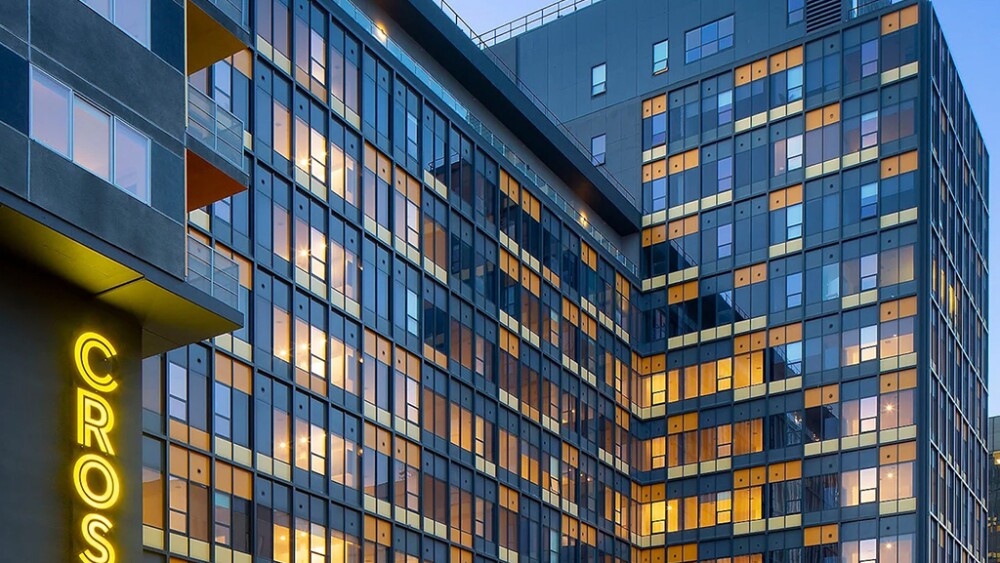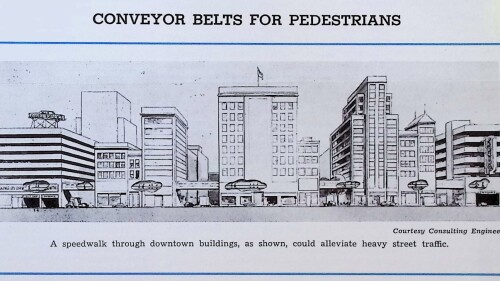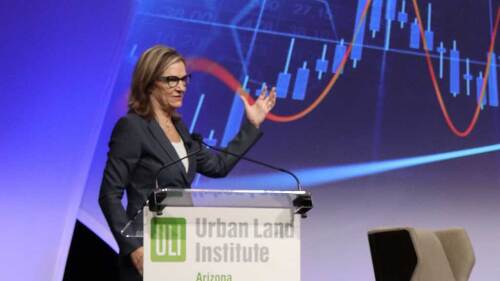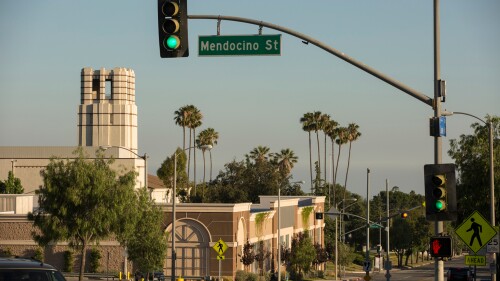
The 12-story Koreatown office building, located at the southwest corner of Wilshire Boulevard and Catalina Street in Los Angeles, opened in 1957 as the West Coast headquarters of the oil and gas company Texaco. Jamison Service’s reimagining of the 62-year-old building transforms its interior into 216 units of multifamily housing while retaining existing street-fronting retail space.
Jamison Services
As the office vacancy rate hovers around 20 percent, cities throughout the United States are grappling with the fallout: Fallen asset values. Reduced tax revenues. Urban blight.
Against this backdrop, some local governments are rolling out new and updated programs—including tax incentives and zoning amendments—to encourage developers to convert vacant office buildings to some other use.
Although conversion is not a panacea for our office woes, it is a tonic and has the potential to bring vitality back into office-heavy downtown districts.
“If you’re walking down the street and there’s a vacant building, there’s empty or boarded up retail, it has detrimental effects on the community, small businesses, safety, and tax revenue,” says Nick Gregorios, a principal at Avison Young who also serves as a commissioner and the vice chair of the Arlington Economic Development Commission, which advises Arlington County. “There’s a whole slew of negative effects. By converting and converting quickly, that helps condense [the] period of time [when], otherwise, it could be a blighted property.”
By some estimates, around 15 percent of U.S. offices are suitable for conversion. Whereas the first batch of post-pandemic initiatives was all about office-to-residential conversions, some cities now want to encourage conversions into a broader mix of property types. After all, people don’t like renting apartments in areas with paltry retail and dining options. A diversity of property types—hotels, retail, even self-storage—make formerly office-centric districts economically viable in the long term.
Leaning into diversification in early 2025, Washington D.C. introduced its Office to Anything program, which focuses entirely on boosting nonresidential office conversions downtown. The city is incentivizing housing conversions with a separate program, Housing in Downtown, which launched in 2024.
“Our downtown skews heavily office,” says Chad Shuskey, chief operating officer of the Washington DC Economic Partnership. “[After] the pandemic, it became clear that neighborhoods with more mixed uses had an easier time economically.”
Office to anything
Washington, D.C.’s Office to Anything program offers a 15-year tax freeze to developers who turn offices into other commercial spaces. Its Housing in Downtown incentive offers a 20-year tax abatement for office-to-residential conversions.
Both D.C. programs are designed to support the city’s ambition to add 15,000 new residents to its downtown area by 2028. The pair stems from an understanding that, without incentives, conversion math rarely works for developers—especially as an era of toxic uncertainty stymies capital markets.
“These incentives signal that the city recognizes that developers in today’s challenged capital environment need help from the municipality . . . to move forward with development,” says Suzanne White, vice president of Washington DC Economic Partnership.
Although the new Office to Anything program has no awardees yet, developers are showing a growing interest in conversions. Local developer Taicoon Property Partners is pursuing Office to Anything incentives to convert Class B and C offices with occupancy rates below 40 percent.
Earlier this year, the firm submitted a proposal to convert an office near Capital One Arena into a hotel, according to Suzanne Pyles, managing director at Taicoon. Because of site constraints, that project ultimately didn’t pencil out, but the firm is now evaluating a different downtown office-to-hotel conversion.
“These incentive programs can be what moves the needle and gets a deal across the line,” Pyles says. “Just knowing that D.C. is doing everything it can to help businesses succeed is a big reason we’re still focused on the city itself.”
Removing barriers to conversion
Across the Potomac River, Arlington County, Virginia, is also taking action to foster conversions and reduce the economic impact of vacant office spaces. Its focus is on removing regulatory barriers.
In November 2024, the county adopted an adaptive reuse policy that streamlines approval processes for conversions from office to other uses, and that amends the county’s zoning ordinance. Arlington designed the policy to support both residential and mixed-use conversions, according to Gregorios of the Arlington Economic Development Commission.
Within 90 days of launching the incentive, the county received proposals for three residential conversions and one hotel conversion, all of which could include ground-floor retail, Gregorios says.
Arlington’s approach aims to prioritize speed to market by reducing the time projects collect dust in the review process. Faster approval timelines make projects less costly for developers, who hire teams of lawyers, engineers, and architects to navigate the process.
Typically, approvals in the region used to take one to three years, Gregorios says. County leaders hope to shorten that period to four to six months under the adaptive reuse policy.
The projects using the program total roughly 800,000 square feet (74,300 sq m), which accounts for approximately 2.5 to 3 percent of Arlington’s existing office inventory, Gregorios says. Although not all proposed projects will materialize, he sees rising interest in conversions as an indicator and thinks that the right incentives can help spur momentum.
“In a market like Virginia or D.C., but potentially even nationally, the general consensus among developers, operators, and local officials is that somewhere between 8 percent and 15 percent—maybe even up to 20 percent—of the office inventory will be converted over time,” Gregorios says.
A burgeoning housing pipeline
Although cities increasingly recognize the value of a more diverse adaptive reuse strategy, office-to-residential conversions remain the most popular, as the country continues to grapple with housing shortages.
A record-breaking 70,700 apartments are set to come from converted offices in 2025, a significant increase from the 23,100 that were in the pipeline in 2022.
The carryover of pending projects from one year to the next is quite large, however, suggesting that such factors as conversion feasibility, construction costs, and local incentives play an essential role in whether projects actually materialize.
Not surprisingly, cities that had adaptive reuse strategies in place before the pandemic are now leading in conversion activity. New York now represents the gold standard for turning offices into apartments. It currently has 8,310 conversions in the pipeline.
Building on its long track record of successful conversions that date back to the 1990s, the city introduced the Office Conversion Accelerator program in 2023 and the City of Yes for Housing Opportunity in 2024.
At the state level, the 467-m tax exemption went into effect in early 2025. It also helps developers create more housing.
Part of New York City’s success lies in its clearer zoning rules compared to ones in many other jurisdictions. In New York, developers can build properties by-right citywide. That means that as long as they follow clearly defined rules and standards, such as keeping within floor area ratio limits, they don’t need to obtain the discretionary approvals that often stall projects and increase their costs.
By-right development is key
Leaders in other cities, including Los Angeles, hope to enact more by-right development to spur conversions and increase housing stock.
L.A.’s existing Adaptive Reuse Ordinance, enacted in 1999, allows conversions by right only in Downtown and other historic neighborhoods, including Hollywood and Koreatown. Although the ordinance has increased L.A.’s housing stock, that city’s zoning regulations remain far more restrictive than New York’s.
To accelerate the pace of conversions, L.A. City Planning is now working on a citywide ordinance that, if approved, would allow adaptive reuse by right across more neighborhoods. The expansion would also permit the repurposing of buildings that are just 15 years old, easing the development standards typically applied to new construction. The ordinance was expected to be approved in February but was sidelined by the Eaton and Palisades fires.
L.A.–based Jamison Properties is the most active developer applying the extant adaptive reuse ordinance to convert its robust portfolio of aged offices—many of them in and near Koreatown—to housing. Garrett Lee, president of Jamison, says he’s eager for the new citywide ordinance to get over its “final hurdle” to enactment. Jamison is waiting for the citywide adaptive reuse ordinance to go into effect before the developer launches several conversion projects.
“By-right development makes a huge difference for developers because the uncertainty of entitlements and opposition from community or labor groups can really make a project not as attractive and too much of a financial risk,” Lee says. “So, the citywide ordinance really does open the door to [the possibility of] those buildings becoming much more viable for conversion.”
In addition to opening up the geography where Jamison can develop, the new ordinance, if enacted, would remove the density limit, which requires units to average 750 square feet (70 sq m).
“There’d be no limitation on unit sizes, so you could build smaller units and get more units into your buildings,” Lee says.
Jamison has completed nine conversions since 2013, with four more currently under construction. One of them, once a 13-story Koreatown office building, is being converted into a 236-unit residential building with 15,000 square feet (1,400 sq m) of ground-floor retail space. Lee expects it will be completed in 2026.
Affordable housing in focus
In addition to New York and Los Angeles, several other U.S. cities are rolling out targeted incentive programs to support office-to-residential conversions, often tying them to affordable housing goals.
Montgomery County, Maryland, approved the More Housing N.O.W. incentive in April 2025. It includes zoning amendments and offers a 20-year property tax abatement for projects that meet affordability requirements.
Boston extended its office-to-residential conversion program in 2024, with $15 million in funding from the state of Massachusetts. The program offers developers as much as $215,000 per affordable unit, with a $4 million cap per project, to encourage more office conversions in the city’s urban core. Applications are open through December 2025.
Financing makes the difference
The U.S. is slowly adapting to a post-pandemic reality. Of course, due to hybrid work, that means less office space is needed—but it also means that many companies are set on Class A, amenitized buildings for the office space they do need, leaving older Class B and C buildings in the dust.
Against this backdrop, conversions are no longer a niche solution but a mainstream strategy for urban revitalization.
The success of conversion incentive programs will depend ultimately on the creativity and flexibility of each city. Clear policy frameworks, strong public/private collaboration, and—perhaps most notably—financial incentives will determine whether conversion programs become a widespread engine for transforming outdated office districts into vibrant communities.
“At the end of the day, it all comes down to whether the project pencils or not,” Lee says. He adds that any and all programs to lower the cost of conversion are direly needed in L.A., “due to the housing shortage, especially after the fires.”











